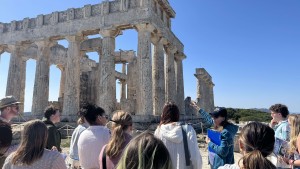I saw the Greek island of Aegina for the first time in the fall of 2023, on a slide in the class “Illegal Antiquities.” In that particular lecture, Professor Zoë Kontes explained how the Temple of Aphaia, built in the Doric order and situated atop a hill overlooking the Saronic Gulf, was plundered for King Ludwig I of Bavaria in the early 19th century. Today, its pedimental sculptures, once painted in bright colors to depict a battle between the Greeks and the Trojans, remain in the permanent collection of the Glyptothek in Munich.
Over spring break, I made it to Aegina — and to the Temple of Aphaia — in person. In advance of our trip, the students of CLAS 121 (Greek Archaeology) had spent the first seven weeks of the semester learning everything we could about the surviving material evidence from ancient Greece, ranging from Bronze Age Cycladic figurines to the Early Classical architectural innovations that would lead to the construction of the Parthenon.
But, in addition to our desperate efforts to memorize the names and approximate creation dates of sculptures and pottery ahead of our departure, we also got a crash course in archaeological ethics.
It’s relatively easy to sit in a classroom in Gambier and pontificate about what objects should go where and why. It’s comparatively much harder to fly to Greece, fight jet lag in an unfamiliar city, wake up early to get on a bus, sit in Athenian rush hour traffic on the way to the port of Piraeus, run at full speed across the port to make a ferry on time, spend an hour on a boat, and climb up the side of a mountain (okay, fine, a hill) to truly understand why archaeological ethics matter.
On that morning, laughing with my classmates as the beautiful Aeginetan sunshine started to burn my shoulders, I had a thought that I’m not proud of: I see why someone would want to take a piece of this home with them.
Of course, C.R. Cockerell and the other would-be archaeologists involved with plundering the Temple of Aphaia were doing more than simply preserving mementos from a day well spent. For them, it was about power; by drawing a through line from antiquity to themselves, they were claiming ownership of a fantasized version of the classical past. In it, gods and heroes roamed the topography of Greece while mortals poured libations and fought valiant battles like the one shown on the Aphaia pediments. For Cockerell and friends, it was worth it to buy the silence of the local Aeginetans as they smuggled those pediments out of the country in order to claim a piece of that fantasy.
As would-be archaeologists ourselves, my classmates and I took a different approach. We roamed the perimeter of the temple, taking note of the divots in the steps where lead-coated clamps had been carved out in order to make bullets. We discussed why there has been no significant call for the restitution of the Aphaia pediments despite ongoing global conversations about other, more famous objects stolen from Greece. Perhaps most importantly, we posed for pictures in front of the beige limestone and blue sky — our less destructive way of taking a piece of Aphaia back to Gambier with us.
The ugly truth is that the Aphaia pediments are probably not going to see Aegina again any time soon, if they ever do at all. But by talking about them — not just while physically standing in front of the temple, but in a cozy classroom in Ascension, in whispers in the Chalmers stacks, in office hours while glancing at a replica Kamares-ware vase over Professor Kontes’ shoulder — we were conjuring their images, creating a different fantasy of the past where they were never stolen in the first place. More importantly, though, myself and my fellow budding archaeologists of Greece were also developing our archaeological consciences, enabling us to speak out and step up as leaders the next time calls for the restitution of cultural property come to the forefront of the global conversation.
That fall day when I first learned about Aegina in “Illegal Antiquities,” I had recently changed my major to art history. I still wasn’t entirely sure why I had done it — but after that lecture, it became clear to me that my academic interests lay in the thorny ethical and legal debates surrounding the return of stolen cultural property. By the end of the semester, I had changed my minor to classics and jumped into the wonderful world of restitution, repatriation, museums and, yes, archaeology. Climbing up the hill to the Temple of Aphaia that morning — seeing the empty spaces where the sculptures used to be — affirmed that I had made the right choice and that there is still plenty of important work to be done.
